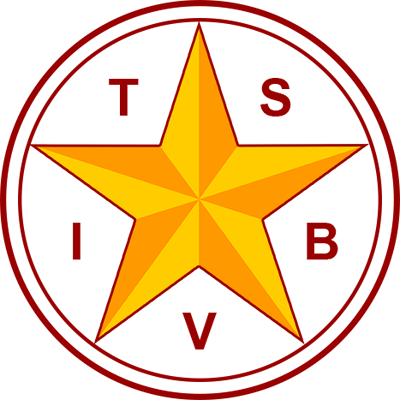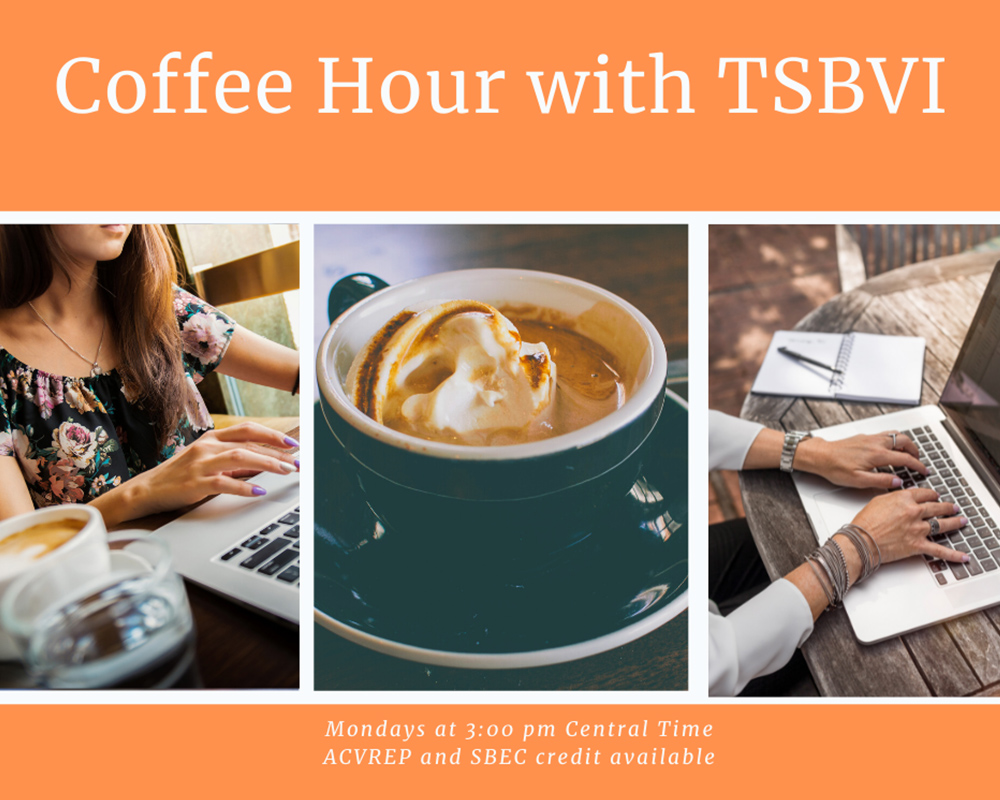E-Learning Course Listing
This page provides a list of all TSBVI e-learning courses currently available for professionals, paraprofessionals, and family members, free of charge. (Note: Bridge registration links on this page are for Non-TSBVI Staff only. If you are a TSBVI employee, please email landrys@tsbvi.edu for instructions.)
How to register and claim CEUs for e-learning:
Step 1. Register in escWorks:
EscWorks is the system that records the CEUs that you have earned through all TSBVI Outreach training activities.
If your course offers credits, register for them using the link that says “Register in escWorks to earn credits for completing this course.”
You will see this link in the description for each course on this page that offers CEUs.
If you do not want CEUs for the course, skip to step 2.
If you do not have an escWorks account yet, please set up your profile here (please use the same email address for escWorks and Bridge).
Step 2. Register in Bridge:
This is the system that delivers and tracks your e-learning courses. Once you have access to Bridge, you can self-enroll in courses by clicking on the link that says “Self-Enroll for the course in Bridge” in the course descriptions on this page.
If you do not have a Bridge account yet, please complete the Bridge access form here.
Please use the same email address in Bridge as you do in escWorks. New accounts are set up each Wednesday evening.
Note: if you are a TSBVI employee, you have to log in to Bridge differently. Please email landrys@tsbvi.edu for instructions on how to access the courses on this page.
Step 3. Claim your credits:
If your course offers CEUs, please notify TSBVI after you have completed the lesson in Bridge. To claim your credits, make sure you have registered for your course in escWorks , then email landrys@tsbvi.edu.
How to self-register and get CEUs for TSBVI e-learning courses
Course Listings
Read course descriptions and register for courses below. Courses that offer CUEs for completion will clearly display the number of awarded hours in the course title section.
BrailleNote Touch Plus (Beginner)
This training is for teachers and family members who need to orient a student to access written information using a BrailleNote Touch Plus notetaker.
This program contains ten courses that you will complete in sequence.
How to Complete This Training
Device Overview
Advanced Setup
Basic Navigation
File Manager
KeyWord Navigation
Notating Math Content
Using KeyCalc
Math Graphs
Graded Program Assessment
Register in escWorks to earn credits for completing this course.
Bioptic Driving: Comprehensive Information for Educators
This program is for educators, administrators, and paraprofessionals. If your students hope to drive with the assistance of bioptic devices, this course will help you understand the concepts and requirements your students must demonstrate to succeed.
Register in escWorks to earn credits for completing this course.
Self-enroll for the course in Bridge
(Note: If you are TSBVI Staff, please email landrys@tsbvi.edu for instructions on registration)
Bioptic Driving: Information for Partner Agencies and Providers
This course provides information about bioptic driving for the staff of medical and government regulatory organizations.
Self-enroll for the course in Bridge
(Note: If you are TSBVI Staff, please email landrys@tsbvi.edu for instructions on registration)
Bioptic Driving: Considerations for Families and Future Drivers
This program is for future drivers and the families of future drivers. For those who want to drive with the assistance of bioptic devices, this course will help explain the concepts and requirements that are essential to understanding the process and skills of bioptic driving.
Self-enroll for the course in Bridge.
(Note: If you are TSBVI Staff, please email landrys@tsbvi.edu for instructions on registration)
Bioptic Driving: Foundations
Introductory course on the methods and requirements for becoming a driver who uses a bioptic. For more specific content, we offer courses for families and future drivers, education professionals, and staff of partner organizations.
Self-enroll for the course in Bridge.
(Note: If you are TSBVI Staff, please email landrys@tsbvi.edu for instructions on registration)
Teaching Telescope Skills to Students with Low Vision
A telescope provides distance visual access for a person with low vision. Knowing how to use this tool is not automatic and explicit instruction is necessary.
Learners will be able to:
- Identify the rationale for providing instruction in telescope use,
- define general principles of distance viewing,
- name the specific seven skills needed for efficient and effective use of a telescope,
and
- list strategies for supporting student psychosocial development as a device use.
Gaining proficiency with this tool requires ongoing practice sessions across a range of environments with motivating visual targets. The telescope empowers a person to see what they want to see to enrich their world.
Register in escWorks to earn credits for completing this course.
Self-enroll for the course in Bridge
(Note: If you are TSBVI Staff, please email landrys@tsbvi.edu for instructions on registration)
Introduction to the Intervener Team Model Training
This is training for team members who are working with a deafblind student who has been assigned an educational intervener or one-on-one professional.
Interveners need specialized skills related to deafblind-specific needs in order to provide one-on-one instructional support to students who are deafblind. They need appropriate supervision and support from the IEP team. To help meet the needs of interveners in Texas, the Texas Deafblind Project at Texas School for the Blind and Visually Impaired is pleased to announce the online Introduction to the Intervener Team Model Training.
This training is designed to support the team. If you are an intervener without a team to register with you, please contact us at txdeafblindproject@tsbvi.edu.
Topics:
- Impact & implications of being deafblind]
- Intervener competencies & training updates
- Intervener and team roles & responsibilities
- The five components of quality intervention
- Intervention issues & considerations
- Identification of tools and strategies to support the student profile
We recommend the following methods of completing this module as a team:
- Identify your team members (i.e. TVI, classroom teacher, TDHH, COMS, Administrator, family members, etc.) and set up weekly study sessions to complete the course.
- All interested team members should enroll in the course through both Bridge and ESC Works.
- If all team members work individually on this course, nothing additional needs to be completed.
- If you want to work on this course together, using one computer, please email Steven Landry at landrys@tsbvi.edu for further instructions before you enroll.
Register in escWorks to earn credits for completing this course.
Self-Enroll for the course in Bridge(Note: If you are TSBVI Staff, please email landrys@tsbvi.edu for instructions on registration)
Principles of Active Learning
This self-paced course covers the basic principles of Active Learning, an approach developed by Dr. Lilli Nielsen of Denmark. This approach is used to provide instruction to individuals with visual impairment, who are deafblind, and who are developmentally below the age of 48 months, no matter their chronological age. In addition to visual impairment, many of these learners have significant physical, cognitive and emotional delays.
The Active Learning approach emphasizes that all individuals learn best by active participation. In the earliest stages of learning (sensorimotor and early preoperational stages) it is this active participation which actually “wires the brains” of all human learners.
This course includes content from the Active Learning Space website which is a collaborative project developed by Penrickton Center for Blind Children, Perkins School for the Blind, and Texas School for the Blind and Visually Impaired.
This course contains the following content areas:
- Overview of Active Learning: Broad description of Active Learning.
- What Is Play?: Play is the vehicle for learning for all individuals in the earliest stages of development. This step in the module will define “play” and explain why it is a key learning strategy.
- Pathways to Learning: Each learner has a unique profile based on available sensory channels. Understanding what sensory channels are available to the learner is key to developing appropriate learning environments and activities.
- Dynamic Learning Circle: All learners go through four stages of learning. Breakdowns can occur in any stage of learning and educators must learn to identify where there are breakdowns in this process in order to provide appropriate learning activities and environments.
- Emotional Development: Learning is not only about cognitive and physical development, but also emotional and social development. Understanding the importance of a learner’s emotional development and how it impacts cognitive and physical development is discussed in this step.
- Key Points of Active Learning: This summarizes some of the key points in implementing an Active Learning program for a learner.
- Communicating with the Learner: This step discusses the importance of not interrupting a learner’s process with unnecessary talk or interactions.
- Five Phases of Educational Treatment: This shares information about how the adult should interact with the learner based on the learner’s social and emotional development.
- Phase 1: Offering
- Phase 2: Imitation
- Phase 3: Interaction
- Phase 4: Sharing the Work
- Phase 5: Consequences
Completion of this course will provide you with 12 CEU credits approved through ACVREP and SBEC. You must pass the course assessment with a grade of 80% or better to receive these credits.
Register in escWorks to earn credits for completing this course.
Self-Enroll for the course in Bridge
(Note: If you are TSBVI Staff, please email landrys@tsbvi.edu for instructions on registration)
CVI Course Information
TSBVI is proud to offer a self-paced online course to help team members better understand and more accurately complete Christine Roman’s CVI Range assessment.
The CVI Web Course consists of three case study simulations of conducting the CVI Range on real students.
Each module follows a similar structure:
- The case study student is presented
- Real-life parent interview answers for the student are discussed
- Review of videos of the student participating in their individual educational settings
- Review of videos of the student’s direct assessment
The students in the modules are presented because they have CVI Range scores that fall within each of the three phases of CVI identified by Dr. Roman:
- Phase I – Building Visual Behavior
- Phase II – Integrating Vision with Function
- Phase III – Refinement of CVI Characteristics
Participants will be provided with opportunities to simulate the evaluation of case study students using the CVI Range:
- Using observation sheets to record data gathered during the interview, evaluation, and direct assessment
- Following along by scoring a copy of the CVI Range book
- Comparing conclusions drawn from the case studies
- Reviewing intervention ideas for each of the students
Using the skills presented in this course will help professionals:
- Understand more about CVI
- Apply that knowledge to their specific students
- More confidently guide the student’s team to apply appropriate interventions for each interfering CVI characteristic across the school day as well as in the home
CVI Scenarios Phase I – Case Study 3: Isaiah
In Phase I Case Study 1: Isaiah, the goal is building visual behavior. This means that a child is beginning to become aware of visual targets in controlled environments. In this case study, we meet a boy who is just barely starting to use his vision. These visual behaviors are subtle and require keen observation skills. This module will help participants begin to hone those skills.
Register in escWorks to earn credits for completing this course.
Self-Enroll for the course in Bridge
(Note: If you are TSBVI Staff, please email landrys@tsbvi.edu for instructions on registration)

